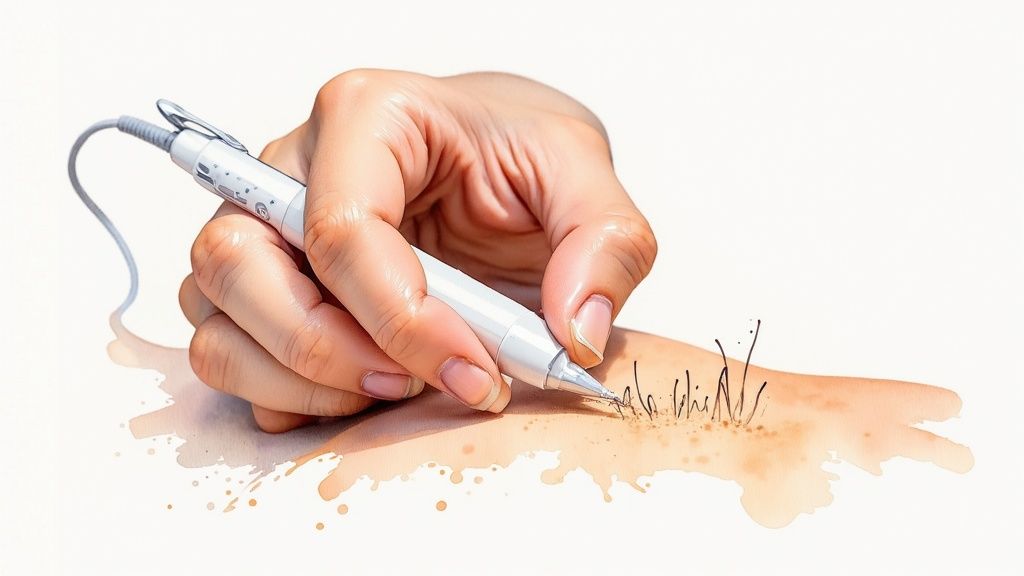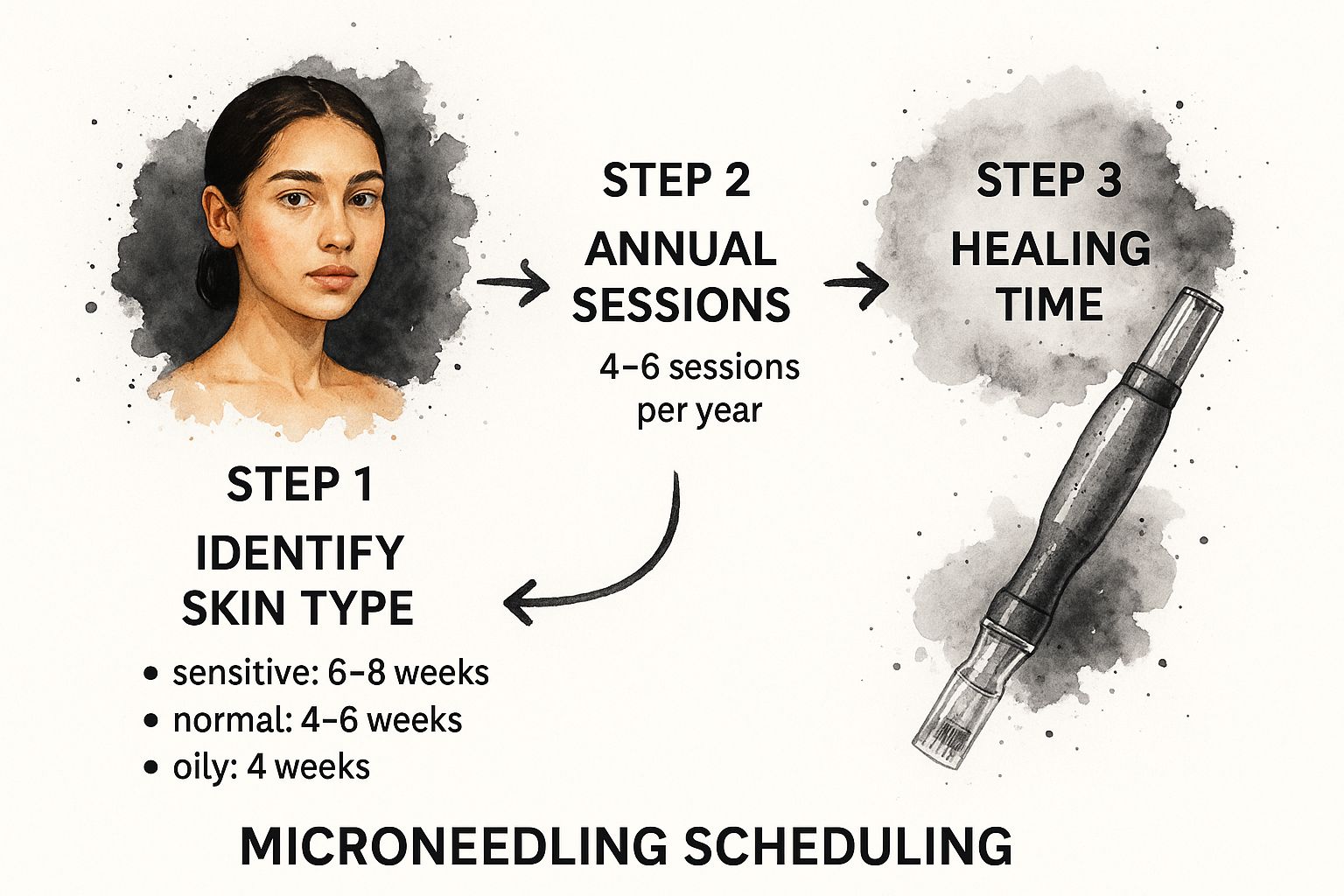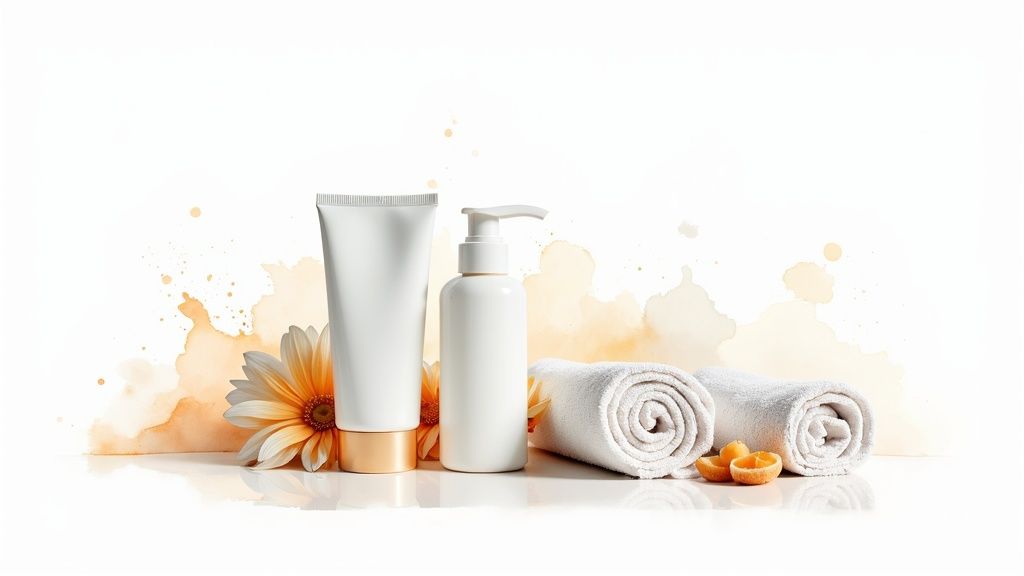
How Often to Do Microneedling for Best Results
So, you're wondering, how often should I get microneedling done? The gold standard for most people is every 4 to 6 weeks. This isn't an arbitrary number; it's the sweet spot that gives your skin enough time to fully heal and kickstart that amazing collagen and elastin production process.
Your Quick Guide to Microneedling Frequency

While that 4-6 week window is a fantastic starting point, think of it more as a baseline than a hard-and-fast rule. The truth is, your ideal schedule really depends on what you're trying to achieve with your skin.
Someone looking to soften deep, stubborn acne scars will need a more intensive plan than someone who just wants to maintain that fresh, radiant glow. The magic of microneedling is that each session builds on the last. It's a cumulative process that gradually remodels your skin from the inside out.
Let's break down why that 4-6 week timeline is so crucial. It aligns perfectly with your skin's natural regeneration cycle. Spacing treatments within this window gives your skin the downtime it needs to heal completely while maximizing that collagen-building momentum.
Timing is everything with microneedling. Go too soon, and you risk disrupting the delicate healing process. Wait too long, and you lose the powerful cumulative effect that drives real change.
Tailoring Your Treatment Plan
Your personal microneedling schedule will be fine-tuned based on a few key factors. It's all about creating a plan that's just right for you. Here’s what a professional will consider:
- Your Main Goal: Are you fighting fine lines, tackling deep wrinkles, fading sun spots, or just improving overall texture?
- The Severity of the Issue: Minor textural irregularities will require a much different approach than significant, long-term scarring.
- Your Skin's Natural Healing Ability: Everyone’s skin recovers at a slightly different pace, and that plays a big role in scheduling.
- The Intensity of the Treatment: The depth of the microneedles used directly affects how much recovery time your skin needs between appointments.
To give you a clearer picture, here’s a quick reference table that breaks down common treatment plans based on different skin concerns.
Quick Guide to Microneedling Frequency by Skin Concern
| Skin Concern | Recommended Initial Sessions | Frequency | Maintenance Schedule |
|---|---|---|---|
| Fine Lines & Wrinkles | 3-6 sessions | Every 4-6 weeks | 1-2 times per year |
| Acne Scars (Mild) | 3-4 sessions | Every 4 weeks | Once a year |
| Acne Scars (Severe) | 6-8 sessions | Every 6 weeks | Twice a year |
| Hyperpigmentation | 4-6 sessions | Every 3-4 weeks | As needed, or once a year |
| General Rejuvenation | 3 sessions | Every 4-6 weeks | 2-3 times per year |
Understanding these elements helps you and your practitioner build a truly personalized plan. This tailored approach is what ultimately delivers the beautiful, lasting results you're looking for.
The Science of Your Skin's Healing Cycle
To really get why that 4 to 6-week waiting period between microneedling sessions is so important, it helps to think of the treatment as a controlled workout for your skin. Each session creates thousands of tiny, precise micro-injuries, which is like sending a signal to your body to kickstart a powerful, three-stage repair process. This natural healing cascade is the real secret behind the treatment's incredible results.
When you understand how your skin heals, you see why timing is everything. Rushing into your next appointment can do more harm than good, interrupting the very collagen-building work you’re trying to encourage.
Phase 1: The Inflammation Stage
Right after your session, your skin jumps into action. This first phase, inflammation, usually lasts for the first 24-48 hours. It’s your body’s emergency response team, sending immune cells to the area to clean out the micro-channels, clear debris, and get the site ready for rebuilding.
That redness and mild swelling you see? That's a good thing! It’s a clear sign that the healing process has officially begun.
Phase 2: The Proliferative Stage
Starting around day three and continuing for several weeks, your skin enters the proliferative phase. This is where the magic really starts to unfold. Your body gets busy building a brand-new foundation, creating fresh collagen (specifically Type III), elastin, and other building blocks of healthy skin.
New tissue begins to fill in the micro-channels, leading to a smoother, more refined surface. This is the active construction stage, where your skin is hard at work laying down the framework for lasting improvement.
Think of it like this: Phase 1 is the demolition crew clearing the old site. Phase 2 is the construction team pouring the new foundation and framing the structure. Interrupting this stage is like trying to paint before the walls are even built.
Phase 3: The Remodeling Stage
The final and longest phase is maturation, or remodeling. This crucial stage can last for a year or even longer after a treatment. During this time, the weaker Type III collagen that was quickly laid down gets gradually replaced by stronger, more durable Type I collagen—the very type that gives youthful skin its resilience and bounce.
This slow-and-steady process is what leads to those visible improvements in skin firmness, texture, and the fading of scars. By waiting the full 4 to 6 weeks between sessions, you're giving your skin the uninterrupted time it needs for this essential remodeling. Each new treatment then builds upon a stronger, healthier foundation. It's a marathon, not a sprint, but this final step is what solidifies your results. While you might notice a glow pretty quickly, you can learn more about the full timeline for microneedling results in our detailed guide.
This handy infographic breaks down how your skin goals can influence the ideal treatment schedule.

As you can see, aligning your session frequency with your skin’s needs is the key to supporting its natural healing cycle and getting the best possible outcome.
Tailoring Your Microneedling Schedule

When it comes to figuring out how often you should get microneedling, there’s no magic number. A one-size-fits-all schedule just doesn't work because everyone's skin is different. The plan that helps someone fade fine lines might be completely wrong for tackling deep acne scars.
Think of it like hiring a personal trainer for your skin. Your specific goals—whether you want to build strength or improve endurance—will shape your workout routine. It’s the exact same idea here. We need to match the treatment frequency to the skin concern you're trying to solve.
Targeting Fine Lines and General Rejuvenation
If your goal is to soften those early signs of aging or just give your skin an overall boost in radiance and texture, you don’t need to be overly aggressive. The aim is to gently and consistently stimulate collagen to keep everything firm and glowing.
- Recommended Frequency: Every 4 to 6 weeks.
- Initial Series: A good starting point is 3 to 4 sessions.
This timing gives your skin plenty of time to go through its full healing and collagen-building cycle between appointments. It’s a fantastic approach for being proactive about skincare and maintaining that youthful look without putting your skin through too much stress.
Addressing Acne Scars and Texture Issues
Acne scars, especially the pitted or indented kind, are a different ballgame. These scars are essentially pockets of damaged collagen, so our job is to break down that old, disorganized tissue and encourage the growth of new, healthy collagen to fill in the gaps.
Deeper scars need more "remodeling" work to rebuild the skin's foundation from the inside out. That means you'll need a longer series of treatments to see a real, noticeable difference in smoothness and depth.
The depth and age of a scar play a huge role in the treatment plan. Newer, shallow scars might improve after just a few sessions, but older, deeper scars demand a more persistent approach to truly remodel the tissue underneath.
Fading Hyperpigmentation and Sun Damage
For issues like sun spots, melasma, or other discolorations, microneedling works by speeding up cell turnover. The treatment helps to physically break up the little clusters of pigment and push your skin to create new, evenly-toned cells to replace them.
- Recommended Frequency: Every 4 weeks.
- Initial Series: Plan on 4 to 6 sessions.
Keeping the interval at four weeks is often effective for pigmentation because the main goal is to accelerate the rate at which fresh, unpigmented cells come to the surface. For an extra punch, combining these treatments with a good topical brightening serum can really enhance the results.
Most professionals follow these kinds of customized schedules. For lighter concerns like the first signs of aging, 3 to 4 sessions spaced four to six weeks apart is a common recommendation. But for more significant issues like deep-set wrinkles or severe scarring, a more intensive series of 6 to 8 sessions is often needed to get the job done right.
You can learn more about how skin conditions impact your microneedling schedule and get more detailed advice. This tailored strategy is the key to making sure you're on the fastest, most effective path to hitting your skin goals.
How Needle Depth Affects Your Treatment Plan
When it comes to microneedling, one size definitely does not fit all. One of the most important factors that dictates how often you should book your appointments is the needle depth. Your practitioner chooses this based on exactly what you’re trying to achieve, and it directly impacts the treatment's intensity and your skin's healing time.
I like to use the analogy of working on a lawn. If you just want to help your grass absorb a bit more water and fertilizer for a quick green-up, a light pass with short aerator tines does the trick. But if you’re trying to break up deeply compacted soil or thick thatch—think of this as scar tissue—you need longer, more powerful tines that go much deeper. That kind of intensive work means the lawn needs more time to recover. It's the same principle with your skin.
Superficial vs. Deep Treatments
Shorter needles, usually in the 0.25mm to 0.5mm range, create very shallow micro-channels in the skin’s surface. This is perfect for boosting the absorption of your favorite serums and giving your skin a gentle nudge to produce more collagen for that healthy, radiant glow. Since this is just a light stimulation, the skin bounces back quickly, and you might be able to schedule these sessions a bit closer together.
On the other hand, deeper treatments that use needles from 1.0mm to 2.5mm are the heavy hitters. We use these to tackle more stubborn issues like breaking down old scar tissue or triggering a serious collagen-building response to smooth out deep-set wrinkles. As you can imagine, this requires a much more involved healing process. You absolutely must wait a full 4 to 6 weeks—sometimes longer—between these sessions to give your skin the time it needs to fully regenerate.
Rushing into another deep treatment too soon is a classic mistake. It actually interrupts the most important part of the healing process—the remodeling phase, where all that new, strong collagen and elastin are being laid down. Patience here is what gets you those incredible, long-lasting results.
Needle Depth Impact on Microneedling Frequency
So, how does this all tie into your schedule? It’s pretty straightforward: the deeper the needles go, the more downtime you'll need, which means a longer wait between appointments. A skilled professional will always customize the depth for you, striking the perfect balance between effectiveness and safety for your skin.
This table gives you a good sense of how different needle depths line up with various skin concerns and the typical waiting periods.
| Needle Depth (mm) | Primary Target Concern | Typical Downtime | Recommended Frequency |
|---|---|---|---|
| 0.25 - 0.5 | Enhanced product absorption, general rejuvenation, very fine lines | 24 hours of mild redness | Every 3-4 weeks |
| 0.5 - 1.0 | Mild acne scars, fine lines, uneven texture, enlarged pores | 1-3 days of redness and light peeling | Every 4 weeks |
| 1.5 - 2.5 | Deep acne scars, surgical scars, significant wrinkles, stretch marks | 3-7 days of redness, swelling, and peeling | Every 4-6 weeks |
Knowing this helps you have a much more productive conversation during your consultation. You can ask your aesthetician why they're recommending a certain depth and understand how it fits into your overall treatment plan. This ensures your microneedling journey is perfectly set up to deliver the best possible outcome without pushing your skin past its limits.
Comparing Professional vs At Home Microneedling

First things first, let's clear up a common misconception. Professional microneedling and at-home derma rolling are worlds apart. Thinking of them as the same thing is a recipe for frustration and, frankly, can be unsafe. The tools, the technique, and the sheer intensity are completely different, which is why their treatment schedules are, too.
When you get a professional treatment, a licensed aesthetician is using a sterile, medical-grade device. The needles are adjustable and much longer—usually between 0.5mm to 2.5mm—allowing for deep, controlled micro-injuries that actually reach the dermis. This is where the magic happens; it's what kicks that powerful collagen and elastin production into high gear.
Because the treatment is so much more intensive, that 4-6 week waiting period isn't just a suggestion, it's essential. Your skin is undergoing a serious remodeling process, rebuilding its very foundation. You simply can't rush that.
At-Home Tools: A Different Approach
Now, let's talk about the derma rollers you can buy for home use. These are designed with much shorter needles, typically around 0.25mm to 0.3mm. They aren't built to penetrate the dermis or spark a major collagen overhaul. Instead, their job is to create tiny, superficial channels on the very top layer of your skin.
Here’s a simple analogy I like to use:
- Professional Microneedling: This is like aerating your lawn. You're punching deep, strategic holes to break up compacted soil so new, healthy roots can grow strong.
- At-Home Derma Rolling: This is more like lightly raking the surface before you fertilize. You're just scratching the top layer to help water and nutrients sink in more effectively.
Because at-home tools are so much less invasive, you can use them more often—maybe once or twice a week, depending on how your skin feels. Their real strength is boosting the absorption of your skincare products, giving your expensive serums a clear pathway to do their job. You can dive deeper into the key differences between at-home vs. professional microneedling to figure out which approach is right for you.
At-home derma rollers are excellent for boosting your daily skincare routine. However, they are not a substitute for professional treatments if you're looking to correct deeper skin concerns like significant wrinkles, texture, or acne scarring.
Ultimately, it all comes down to what you want to achieve. If you’re looking for a surface-level boost and want your products to work harder, an at-home roller is a great maintenance tool. But for true skin transformation—correcting deep-set lines, stubborn texture, or old scars—the precision and power of a professional treatment every 4-6 weeks is the only way to get there.
So, you’ve finished your initial round of microneedling treatments and your skin looks fantastic. That’s a huge win, but the work isn’t quite over. Think of it like this: you wouldn't spend months getting in shape at the gym only to stop going completely, right? The same logic applies to your skin.
To protect the investment you've made and keep that beautiful new collagen from breaking down, you’ll need to schedule periodic maintenance sessions. Your skin is always in a state of change, and these follow-up treatments act as a powerful way to keep the renewal process going, ensuring your complexion stays firm, smooth, and vibrant.
Crafting Your Long-Term Maintenance Strategy
After your initial series, the goal changes from intensive correction to smart preservation. We're no longer trying to make big changes in a short time. Instead, we're shifting to a less frequent schedule designed to hold onto your results and push back against the natural aging process.
For most clients, a single maintenance session every 3 to 6 months is the perfect rhythm. This timing hits the sweet spot—it keeps your collagen production humming along without over-stressing your skin. Of course, the exact timing depends on you, your age, your skin’s starting condition, and even your lifestyle.
Maintenance isn't about starting from scratch. It’s about building on the incredible foundation you've already created. Each follow-up treatment reinforces that collagen framework, making sure your results are here to stay.
Great aftercare is also non-negotiable for making your results last. A solid daily routine is your first line of defense, protecting that renewed skin from the elements. To get the most out of every single session, check out our guide on microneedling aftercare instructions that actually work.
This long-term approach is what turns microneedling from a one-time fix into a central part of your lifelong skin health plan. It’s a strategy that’s clearly catching on, with the market for these treatments projected to grow at a 15% CAGR through 2033. More and more people are realizing that consistency is the real secret to amazing skin.
Common Questions About Microneedling
As you start thinking about your own microneedling plan, it’s completely normal for questions to pop up about timing and what to expect. Getting straight answers is the best way to feel confident about the process. Here are a few of the questions we get asked all the time.
Can I Do Microneedling Every 2 Weeks?
This is a really common one, but the answer is a hard no. Getting professional microneedling done every two weeks is just too much, too soon. It won't actually get you results faster; in fact, it could do the opposite by getting in the way of your skin's healing and collagen-building process.
Your skin absolutely needs that full 4 to 6-week window to regenerate. Cutting that time short can lead to more inflammation, disappointing results, and even potential damage. Letting that collagen-remodeling magic happen on its own schedule is the secret to getting it right.
What Happens If I Wait Too Long Between Sessions?
Don't worry, waiting longer than six weeks between appointments isn't going to hurt your skin. What it will do is slow down your overall progress. The real power of a microneedling series lies in the cumulative effect—each treatment builds on the collagen stimulated by the one before it.
When you stretch the time between sessions too far, you lose some of that incredible momentum. You'll still get benefits from each individual treatment, of course, but sticking to that 4 to 6-week schedule is the fastest route to seeing dramatic, lasting changes.
Think of it like a workout routine. If you skip a week at the gym, you don’t lose all your progress. But it’s the consistent, well-timed sessions that really build strength and create noticeable change.
How Soon Will I Actually See Results?
Right after a treatment, you'll probably notice a nice "glow" for the first week. This is mostly due to a temporary boost in circulation and a little bit of swelling. The real, lasting results from new collagen production take a bit more time to show up.
Most people start to see real improvements in their skin's texture, firmness, and scarring about 4 to 6 weeks after their first session. For those truly impressive, long-term results, you’ll want to complete a full series of three or more treatments.
Ready to map out a microneedling plan that’s built just for you? At Olive Skin Therapy, Olivia Codd puts her expertise to work designing treatments that target your unique skin goals. Book your consultation in Huntington Beach today and take the first step toward healthier, more vibrant skin.
